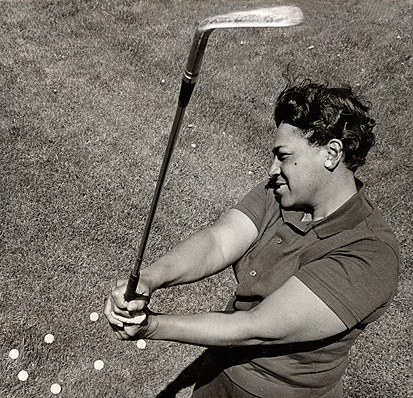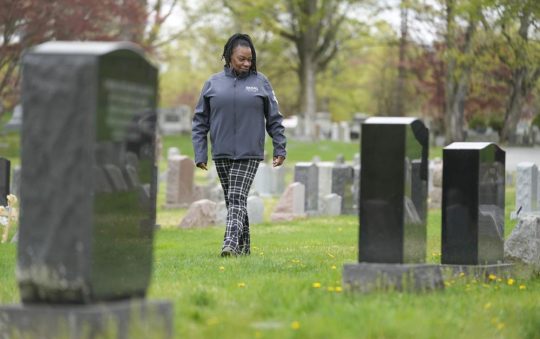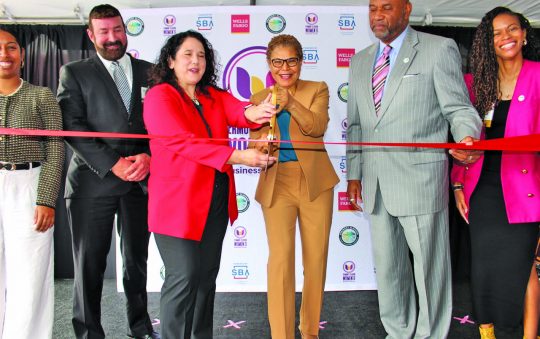
By Rhonda Glenn, USGA
www.usga.org
On Sept. 17, 1956, Ann Gregory teed off in the U.S. Women’s Amateur Championship at Meridian Hills Country Club in Indianapolis, becoming the first African-American woman to play in a national championship conducted by the United States Golf Association.
Other talented female black players would follow, including professionals Renee Powell and Althea Gibson, the great tennis player who turned to golf at the age of 32. But Gregory was the first black woman to compete on the national scene and, arguably, the best.
“She was a determined and confident golfer,” said Powell, “and she was such a warm-hearted, inspirational individual that she helped me by her example, by the kind of person she was. She set the stage for every other black female who came into golf after her.”
In 1963, Gregory was competing in the U.S. Women’s Amateur in Williamstown, Mass. A handsome woman with great warmth, she was by then a veteran who mingled easily with the other contestants, but there had been an embarrassing moment earlier in the week.
Polly Riley, a contestant, was unpacking a suitcase when she saw Gregory, dressed entirely in white, walking in the hall of the inn in which they were both staying.
Mistaking Gregory for a maid, Riley called out, “Hey, can you bring me some coat hangers?”
Moments later Gregory came into Riley’s room and, with a big smile, handed her a bunch of coat hangers.
“I saw then that she had on golf clothes,” said Riley. “I was terribly embarrassed. We’ve laughed about it many times, although that type of thing must have been very difficult for her.”
Gregory, however, had endured worse: she was barred from the public golf course in her hometown of Gary, Ind., denied rooms in white-owned hotels and refused entry to the players’ dinner at the 1959 Women’s Amateur, yet, from some deep well of character, Gregory was able to forgive the indignities.
“Racism is only in your mind, it’s something that you overlook, or you look at it,” said Gregory, at the 1988 Senior Women’s Amateur at Sea Island (Ga.) Golf Club.
This would be her last appearance in a national competition but, at 76, she radiated the vitality of a much younger woman.
“Racism works best when you let it affect your mind,” she said. “It was better for me to remember that the flaw was in the racist, not in me. For all the ugliness, I’ve gotten nice things three times over. I can’t think ugly of anybody.”
Until 1956, when Gregory stepped onto the tee at Meridian Hills, the women’s amateur arena seemed isolated from the emotional racial questions that were now testing the nation. After the 1954 Supreme Court ruling, Brown vs. Board of Education of Topeka, which banned racial segregation in public schools, a body of legislation was evolving in Congress and court actions were aimed at stopping segregation in schools, housing and voting. Earlier in 1956, Rev. Martin Luther King, Jr. had led the Montgomery, Ala., bus boycotts.
In contrast, women’s amateur golf of the 1950s was an enclave of athletic young women who vied for silver cups on a tour of private clubs and resorts. Amateur golf was expensive and, while several players had jobs, many were affluent. Their backgrounds, so different from Gregory’s humble origins, worked in her favor. If the other players were somewhat sheltered, they were also sporting and polite and Gregory would say that she never heard hostile comments from another player.
Breaking Down The Wall
Born July 25, 1912, in Aberdeen, Miss., Gregory was the daughter of Henry and Myra Moore. Her parents died when she was a child, and she was raised by a white family. Fed, clothed, and housed by the family, she also served as its maid. In 1938, she married Percy Gregory and, happy to leave a situation in which she felt she was mistreated, moved with her husband to Gary, Ind.
A good athlete, she won the Gary city tennis championship and soon began taking golf lessons from African-American professional Calvin Ingram. In 1947, after she won a number of black-only tournaments, including the championship of the United Golf Association, an organization for African-American golfers, George S. May invited her to play in the famous Tam O’Shanter tournament in Chicago.
“The galleries were just beautiful to me, but I was lonely. For a whole week I didn’t see any black people,” said Gregory. “My neighbors drove up from Gary to see me play the final round and, when I saw them, that’s the only time I felt funny. It just did something to me to see my black friends among all those white people, and I cried.”
Her husband worked for U.S. Steel while Ann catered for Gary’s University Club, served on the Community Chest and United Fund committees, and in 1954 became the first African-American appointed to the Gary Public Library Board.
In 1956, the Chicago Women’s Golf Association, of which Gregory was a member, became the first black organization to join the USGA, a move to allow her to play in USGA championships.
Gregory immediately entered the 1956 U.S. Women’s Amateur and drove to Indianapolis with Jolyn Robichaux, a friend from the Chicago association.
“We were so excited about the idea of her being in the championship that we didn’t notice any problems,” said Robichaux. “Ann was the type we needed to break that barrier. She was outgoing, told jokes, and was very compassionate and encouraging to the other golfers. They immediately liked her.”
Staying The Course
There was no escape, however, from prejudice. Gregory’s first opponent, Carolyn Cudone, a Curtis Cup player from Caldwell, N.J., recalled an ugly run-in. A parking attendant told Cudone’s father, “Your daughter better win today or you’d better not come back to this parking lot.”
Introduced on the first tee, Cudone got a huge ovation while Gregory received only polite applause.
“Every reporter in Indianapolis was there,” said Cudone. “You couldn’t stir them with a stick! She must have been as nervous as a wet hen because, as we left the tee, she said if she didn’t count her strokes right, it wasn’t on purpose.”
Making several great escapes from bunkers, Gregory took a 2-up lead, and then began to drive wildly. Her lead collapsed and she narrowly lost the landmark match, 2 and 1.
“My husband said I didn’t have a snowball’s chance in hell,” confided Gregory as she congratulated Cudone at the end of the close match. “I guess I fooled him.”
In 1957, Gregory advanced to the third round of the Women’s Amateur but two years later she faced unpleasant conflict at the Women’s Amateur at Congressional Country Club in Bethesda, Md.
On the eve of the championship, the local committee voted to bar Gregory from the traditional players’ dinner. Joseph C. Dey, Jr., executive director of the USGA, broke the news.
“They have decided that you are not to have dinner with them,” Dey told Gregory, explaining that host clubs ran social events at USGA championships.
“I told Joe Dey it was no big deal,” said Gregory. “I told him I realized the money I paid to enter the tournament didn’t buy stock in the clubhouse. I said, ‘I’ll eat me a hamburger and be just as happy as a lark, waiting on tee number one.’ I didn’t feel bad. I didn’t. I just wanted to play golf. They were letting me play golf. So, I got me a hamburger and went to bed.”
One of Gregory’s best performances in national competition followed. In the first round of match play she defeated Mrs. Thaddeus Owings of York, Pa., 1 up. In the second round, she faced Mrs. Curtis Jordan, the Georgia state champion.
Jordan was heavily favored by the gallery and took an early 2-up lead, but Gregory had fans of her own. With Frank Stranahan, the strong Ohio player, cheering her from the sidelines, Gregory rallied and squared the match at the 17th hole. At 18, she fired a 3-iron approach over a pond to the green of the par-3 hole. When Jordan bunkered her tee shot, Gregory had two putts to win the match.
“I stroked my putt, turned my head away, and heard the ball fall into the cup,” she said. “All of the people began to applaud for me. When I made that deuce to win, my caddie turned a somersault. The next day, when I asked for my caddie, the caddie master told me he had been fired.”
Gregory lost her third-round match, 6 and 4, to Diana Hoke, of Chartiers, Pa.
“After I lost, the club president invited me into his office,” said Gregory. “He told me that I had exhibited myself as one of the most beautiful ladies to ever walk that course and he wanted me to know that I was welcome to play there anytime I was in that area.
“I thought, ‘He’s got to be crazy. I would never come back there to play after all of the things they put me through.’ “
Reciprocating Respect
There were other painful incidents. Gleason Park, a public course in Gary, restricted African-American golfers to a short nine-hole layout. Whites played the longer 18-hole course. In the early 1960s, Gregory slapped her money on the counter and announced that she had outgrown the short layout.
“My tax dollars are taking care of the big course and there’s no way you can bar me from it,” she said. “Just send the police out to get me.”
She teed off and played without interference. Soon African-Americans began to make tee times on the 18-hole course.
In 1971, Gregory nearly won the USGA Senior Women’s Amateur at Sea Island Golf Club. In the final round of stroke play (the championship was then a 54-hole competition), only one woman stood between her and a national championship, her old rival from 1956, Carolyn Cudone. But Cudone parred the final hole to defeat Gregory by a single stroke. Gregory remains, however, the only African-American to finish as runner-up in a USGA women’s competition.
Over the years, Gregory and Cudone, who has won a record five USGA Senior Women’s Amateur titles, had become friends and often shared lunch at women’s senior events.
“Ann was a lady and she could play,” said Cudone. “She was a fine competitor; a good winner and a good loser. She played the game as you wanted to see it played.”
Gregory died in Gary in 1990 at 77. Gregory had played during a difficult era against odds that few can ever know. She endured painful slights with warmth, humor, courage and good sense. More than most of us, she cherished the game and, in the end, she honored it.
Check out the Sentinel Sports Section on Facebook and Twitter.
Sentinel Sports Section Facebook page:
http://www.facebook.com/?ref=logo#!/pages/Los-Angeles-Sentinel-Sports-Section/137328139648009
Sentinel Sports Twitter page:






